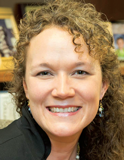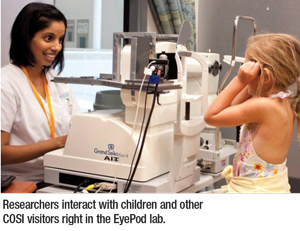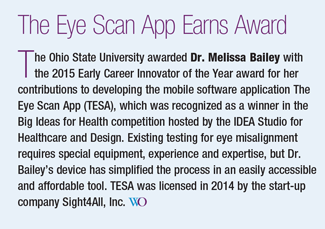

About four years ago, Melissa Bailey, OD, an associate professor at The Ohio State University College of Optometry, learned of a research opportunity at the Center of Science and Industry (COSI) in Columbus, Ohio. The children’s interactive museum had an existing relationship with the university’s Department for Speech and Hearing Science, and there was an opening for optometry to take part in Labs in Life, a laboratory inside the Life exhibition. “COSI wanted guests to be able to see what our real-life research looks like,” Dr. Bailey explains.
Children and adults who visit the EyePod lab, supported by grants, experience and participate in a real research project in action. While guests don’t see the data analysis part of the work, Dr. Bailey says that it is a good representation of allowing the public to see scientists at work. “Our research was very applicable to what the public could understand.” Once Dr. Bailey and her team have presented research at a scientific conference, they share the posters with the museum so that later visitors can see the end-product.


Dr. Bailey and her team have been studying and developing baseline data on the ciliary muscles through research projects at COSI, and in the EyePod lab, they use optical coherence tomography instrumentation to capture images on research participants as young as 3 years old. “I was attracted to the ciliary muscle because it has been ignored over the course of history,” Dr. Bailey says. Up until about a decade ago, the ciliary muscle was not easily visible behind the iris and could only be viewed with an ultrasound biomicroscope, which required probing and was difficult to administer, particularly with children. “There’s no research on the ciliary muscle and how it changes and varies or how to define diseases related to it.” Dr. Bailey and her co-worker hold a patent related to methods for measuring the ciliary muscle, which was developed for analyzing images and collecting measurements.
Dr. Bailey and her students—her future researchers, as she refers to them—have collected photos from several thousand people
ranging in age from 3 to 90 years old. This unique lab location has given the university easier access to study the younger population.


Dr. Bailey says that they are now shifting to examine more functional aspects of the ciliary muscle. “We hope to redefine how we
look at children’s vision related to their focus during reading,” Dr. Bailey says. Now that the exploratory research is complete, Dr. Bailey
will be applying for additional funding for her research through the National Institutes of Health. “We had to define normal first, and now we are far enough along to define abnormal. We hope that one day an optometrist somewhere would know what to look for to
identify a child in advance.”
Down the road, this research may allow ODs to make connections to the ciliary muscle with children who have trouble reading in school. “Do they focus less accurately, or is it that they cannot sustain for as long?” These are questions that Dr. Bailey hopes to answer. Today, there isn’t a test at the clinic that measures if children can focus on a book for a half hour. “Maybe they can use reading
glasses or pursue vision therapy, but if data hints towards the ability to sustain the muscle, we can show how it’s related and identify cases in advance so children don’t have to fail,” Dr. Bailey says.


In addition, the lab at COSI has been cost-effective. Typically, participants are paid for their time and parking when they come to the campus, yet in this location she can tap into the COSI crowds. Dr. Bailey works to staff her space to make sure there’s someone there over school and holiday breaks or during colder weather and in the spring, when more families tend to visit COSI. As it exposes parents and children to something they may have never heard about, it has also “been a great opportunity for students, who are collecting data, and we hope to move into more clinical application in the near future.”
Dr. Bailey says that she also hopes it opens the eyes of her youngest visitors to consider the career possibilities that lie ahead. “When children see a woman who looks like them or their mom, they can picture a woman being a scientist.”



